Multicell interlacing IWP lattice metamaterials with superior low-frequency vibration isolation performance fabricated by laser powder bed fusion
IF 10.3
1区 工程技术
Q1 ENGINEERING, MANUFACTURING
引用次数: 0
Abstract
Lattice metamaterials have been proven to be effective for vibration reduction and isolation, but they do not perform well in the low-frequency bands. In this work, inspired by traditional Chinese Taoist concept, multiple IWP-type TPMS lattices are interlaced with each other to achieve low-frequency vibration isolation. The normal IWP lattice (NIL), double interlacing IWP lattice (DIIL), and quadruple interlacing IWP lattice (QIIL) are designed and prepared by the laser powder bed fusion (LPBF) technique. The frequency response and vibration isolation performance of the TPMS lattice metamaterials are analyzed through the dynamic vibration testing and shaft system vibration testing, respectively. The results reveal that the multicell interlacing IWP lattice metamaterials have better low-frequency vibration isolation performance than body centered cubic (BCC) and normal IWP lattices. With the increase of the interlacing-cell number, IWP lattice metamaterials have a better vibration isolation effect in the low-frequency band. Notably, the 316 L QIIL metamaterials have superior vibration isolation performance with the maximum vibration level difference of 47.44 dB. This study offers a new perspective for the application of lattice metamaterials in low-frequency vibration reduction and isolation.
求助全文
约1分钟内获得全文
求助全文
来源期刊

Additive manufacturing
Materials Science-General Materials Science
CiteScore
19.80
自引率
12.70%
发文量
648
审稿时长
35 days
期刊介绍:
Additive Manufacturing stands as a peer-reviewed journal dedicated to delivering high-quality research papers and reviews in the field of additive manufacturing, serving both academia and industry leaders. The journal's objective is to recognize the innovative essence of additive manufacturing and its diverse applications, providing a comprehensive overview of current developments and future prospects.
The transformative potential of additive manufacturing technologies in product design and manufacturing is poised to disrupt traditional approaches. In response to this paradigm shift, a distinctive and comprehensive publication outlet was essential. Additive Manufacturing fulfills this need, offering a platform for engineers, materials scientists, and practitioners across academia and various industries to document and share innovations in these evolving technologies.
 求助内容:
求助内容: 应助结果提醒方式:
应助结果提醒方式:


